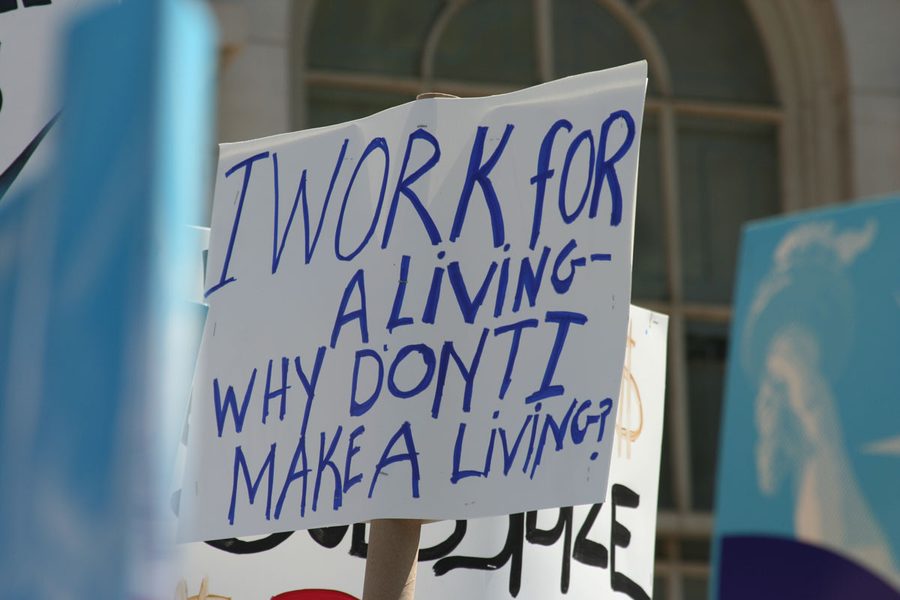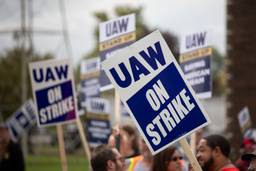
“Your pay is too damn low,” presidential contender Bernie Sanders told union members who called in from around the country to hear from him on Tuesday night.
It’s a message that has echoed from think tanks to politicians and leading academics and back to protesting workers in the street all week long. And bit by bit, the message is shaping public awareness that American workers earning less than $15 an hour — a bit over two-fifths of the workforce — are grossly underpaid. Now this goal, initially seen as utopian but made practical largely by the Fight for $15 movement — is producing significant results.
In New York, the state labor commissioner this week approved the recommendation from a wage board, which had investigated New York City’s fast food industry, that its workers should be paid a minimum of $15 an hour. Then on Thursday Gov. Andrew Cuomo — with Vice-President Joseph Biden at his side — announced that he was launching a campaign, mainly directed at Republicans controlling the state Senate — to set the state minimum wage for all workers at $15 an hour.
Maybe it’s not surprising that Sanders, or even New York politicians (including those regarded as fairly conservative, like Cuomo), would back a $15 minimum wage after that standard was adopted by Seattle, Los Angeles, San Francisco and other jurisdictions, but last week the Democratic National Committee also included a $15 minimum wage in the proposed party platform for next year.
On the same day as the leading New York Democrats were announcing their plans, nearly 100 protestors gathered in the rain outside Chicago’s City Hall demanding that Chicago, which last year raised the minimum wage over a period of three years to $13, catch up with New York and adopt $15 as the minimum for all workers. Although fast food workers led the Chicago protest, many other groups of workers have joined in the Fight for 15: home care workers, child care workers, and nursing home workers who are fighting for $15. (Some have union contracts but at wage levels partly depressed by the low minimum wage.) Constituencies for the campaign continue to grow, increasing its strength.
But in many parts of New York, workers will need a minimum of $21-22 an hour by 2021, according to calculations using data from the Eonomic Policy Institute. The gap between the minimum wage – $7.25 by federal statutes, $8.75 in New York state — and either $15 or $22 is enormous. It is partly filled by taxes that are not sufficiently progressive to support $13 billion a year in public assistance to very low-paid workers.
Workers’ pay has fallen below appropriate levels for all workers, not only because of policy failures, such as not raising the minimum wage, but more generally because workers’ compensation has not kept up with productivity growth from 1973 to the present, as it had from 1948 to 1973, the “golden age” of American capitalism. At the time of the shift, the U.S. economy was beginning to feel pressures from its increasing integration into a global economy that was less controlled by leading governments. Corporations were complaining of a squeeze on their profits. And big businesses were organizing themselves more as a unified force, not just as specific industries, to increase their political influence and to fight unions, consumer advocates (like Ralph Nader), proponents of full employment economic policies, and the emerging environmentalists.
According to a new paper by Josh Bivens and Lawrence Mishel from the Economic Policy Institute, wages did not stagnate because productivity growth slowed (although business-backed policies often did slow productivity growth). Rather, more of wages and salaries went to the corporate elite, and more of income went to owners of capital rather than to workers (and, of course, CEOs benefitted from both trends).
More precisely, from 1973 to 2014 net productivity grew by 72.2 percent, but “inflation-adjusted hourly compensation of the median worker rose just 8.7 percent.” Rising inequality accounts for more than two-thirds of the gap between pay and productivity. And, Bivens notes, just since 2000, the decline in labor’s wage share of corporate income has cost workers $535 billion. (If this money were shared among all workers evenly, every working American would get a raise of $3,770.)
Many different strategies combine to create the inequality gap between the top executives and owners of capital and workers. One set of strategies involves playing off wage and rights differentials in the global economy. Another set, creating “the fissured workplace,” to use the term coined by current Labor Department Wage and Hour Administrator David Weil, minimizes the responsibility of employers and shifts risk to workers.
Last week the National Employment Law Center examined the “on-demand” economy, epitomized by Uber taxi service but including a growing number of other businesses. Although these firms claim to be innovative, the NELP report found them for all practical purposes to be much like old-fashioned “labor brokers,” dispatching workers — who are really their employees, not independent contractors — to provide services for individuals or businesses.
Now most of these “on-demand” workers lose out on the protections workers are provided by law. NELP, for example, found that they should — but typically do not — receive guarantees of minimum wages, right to organize, or social insurance programs (such as social security, Medicare, workers’ compensation and unemployment insurance). The lack of these rights also ends up depriving them of income that goes to their bosses and the company investors.
The decline of unions has been a major cause of this growing inequality, but according to new research by Harvard University professor Richard Freeman and David Madland of the Center for American Progress, the density of union membership in a neighborhood is one of the most important determinants of the degree of economic mobility of poor children (at least as important, for example, as school drop-out rates). Thus the decline of unionism helps to explain why not only has inequality increased but opportunity to move up has decreased in the United States.
For most workers, the problem is not only that their pay is too damn low. It’s also that they have no collective power and voice to do anything about it. That hurts them, their children and the whole country, but it feeds the billionaires.
David Moberg, a former senior editor of In These Times, was on staff with the magazine from when it began publishing in 1976 until his passing in July 2022. Before joining In These Times, he completed his work for a Ph.D. in anthropology at the University of Chicago and worked for Newsweek. He received fellowships from the John D. and Catherine T. MacArthur Foundation and the Nation Institute for research on the new global economy.








